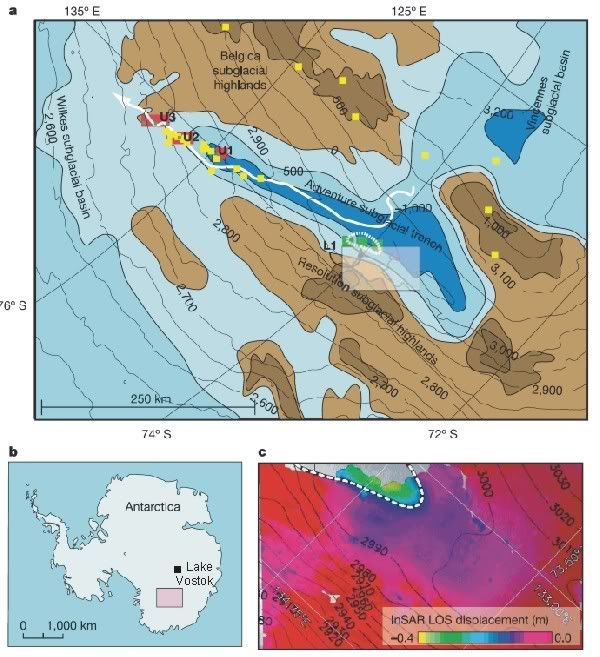For the last few years, there has been much excitement about Lake Vostok, and the numerous other bodies of water which have been found trapped under Antarctica’s 4 km-thick ice sheet. Much speculation has centred on the potential presence of weird and wonderful lifeforms, living in complete isolation from the rest of the Earth’s ecosystems. Such life would be cut off from the sun’s energy, and would have to eke out an existence at low temperatures and very high pressures (due to the overlying ice) – conditions similar to those life would have to endure on Europa, or Enceladus, if it does indeed exist there.
But are these lakes as isolated as we think?
In this week’s Nature, Wingham et al. [1] present an analysis of radar altimetry data from the ERS-2 satellite. This can measure changes in the topography of the ice sheet over time by measuring the distance between the satellite and the surface at the same location on successive orbits. In the data for 1997, they discovered that at three of these ‘crossing points’ in Eastern Antarctica (marked by the green squares, one of which is marked L1, in the rather crowded diagram above), the surface of the ice sheet dropped by 3 metres. Simultaneously, in a region 290 km away, they found three more crossing points (red squares marked U1-U3) where the surface rose by 1-2 m.
The authors propose that this seesaw effect is the result of water being transferred from a large, previously unknown (approximately 600 km2) subsurface lake in the L region to other lakes in the U region (where subsurface lakes – the yellow squares in the first figure – are known to exist). A pressure increase in the first lake, perhaps from the addition of meltwater, was enough to force open channels beneath the ice sheet and allow some water to escape.
Although the actual amount of water transported in this event was a mere 1.8 km3, this research demonstrates that water from these lakes can move around quite quickly, despite the fact that they are covered by many kilometres of ice; large floods could even reach the ocean, affecting sea-level and ocean circulation. These effects seem to be small; even if you completely emptied Lake Vostok, sea-level would only rise by about 1.6 cm (Given an ocean surface area of about 335,258,000 km2, and an estimated volume for Lake Vostok of 5400 km3). Perhaps more important are the biological implications of this work, if (and this is an important if) this phenomenon turns out to be widespread. The BBC report, where I first picked up this story, seemed to very quite gloomy about the chances now of finding unique organisms beneath the ice, with the lead scientist saying:
I think the idea that they have an isolated biological environment where things have gone their own way will have to be re-examined.
I found this quite puzzling; I’m certainly not an expert, but whilst these new data suggest that the Antarctic lakes may be much more interconnected than we thought, they are still effectively cut off from the outside world; I would have thought that a more dynamic environment would be more likely to produce something resembling an interesting ecology. Although it does make the mad dash to drill into Vostok and other lakes seem even more foolish, because if we contaminate one lake, it might not just stop there.
[1] Nature 440, p1033-1036 (doi)
22 April, 2006
How lonely is Lake Vostok?
Subscribe to:
Post Comments (Atom)




No comments:
Post a Comment